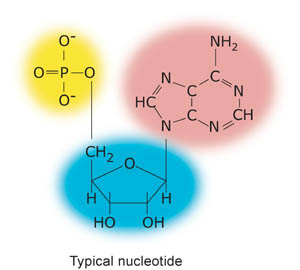Genes
Genes are the discrete units of heredity contained within the DNA double helices of chromosomes. A gene is a specific stretch of DNA and RNA that codes for a type of protein, or for an RNA chain, which has a function in the organism. Living things depend on genes because they specify all proteins and functional RNA chains.
So why are genes important? Genes hold the information to build and maintain an organism's cells and pass genetic traits to offspring. All organisms have many genes corresponding to various biological traits. Some of these traits are immediately visible, such as eye color or number of limbs. However, some of these traits are not immediately apparent, such as blood type, increased risk for specific diseases, or the thousands of basic biochemical processes that comprise life.
The following video explains how DNA is structured:
![]()
![]()
Video 2. Click this link to view Structure of DNA on YouTube (opens in new window).
As we discussed in the macromolecules module, DNA consists of two long polymers of simple units called nucleotides.
Each nucleotide has three components:
- Nitrogenous base (nitrogen-containing)
- Pentose sugar
- Phosphate group

Figure 3. In the diagram above, the phosphate is highlighted in yellow, the sugar (in this case ribose) in blue, and the nitrogenous base in pink.
The nucleotides are arranged so that the DNA strands have backbones made of sugars and phosphate groups joined by ester bonds. The backbone of DNA forms the outside of each of the two helices, with the nucleotide bases bound together and stacked in the center of the helix.
The nitrogenous bases found in DNA are:
- adenine (A)
- thymine (T)
- guanine (G)
- cytosine (C)
Figure 4. This diagram shows the chemical structure of the nitrogenous bases found in DNA (from left to right): adenine (A), thymine (T), guanine (G), and cytosine (C).
Since Watson and Crick first published the DNA structure, we have learned that DNA replication, or the copying of DNA, is a biological process that occurs in all living organisms and is the basis for biological inheritance. The process starts with one double-stranded DNA molecule and produces two identical copies of the molecule. Each strand of the original double-stranded DNA molecule serves as a template for the production of the complementary strand. Cellular proofreading and error correcting mechanisms ensure a near perfect result for DNA replication.
Self-Assessment
Test your knowledge by completing the quiz below.



